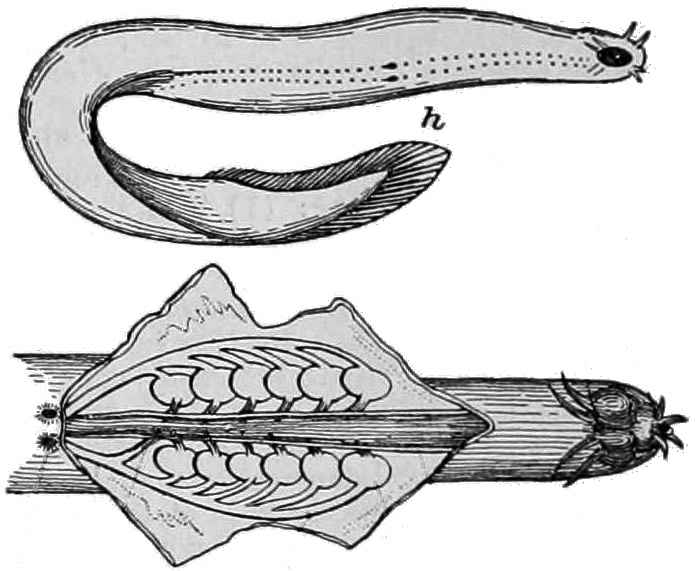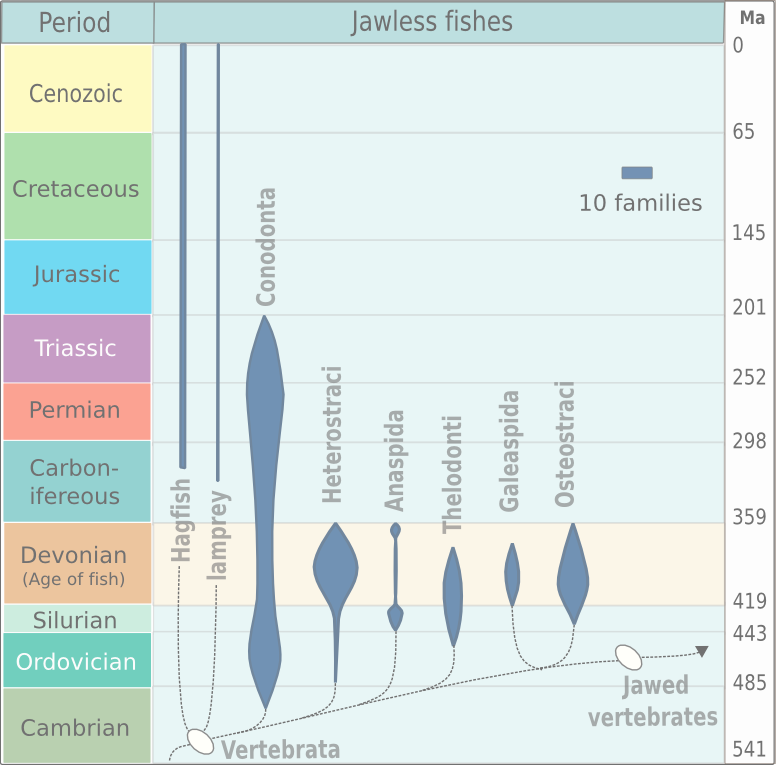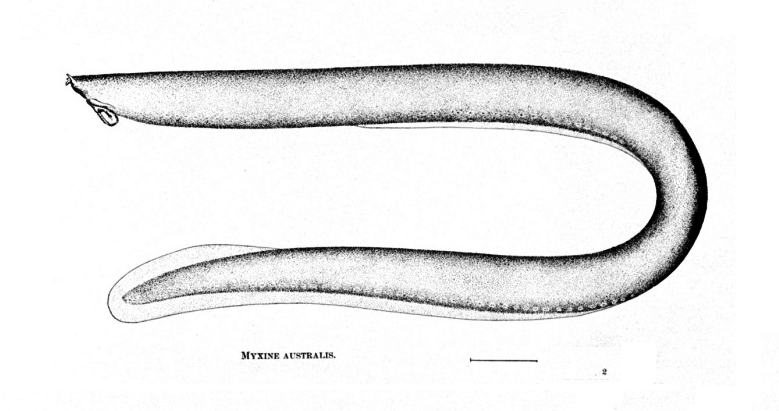|
Hagfishes
Hagfish, of the class Myxini (also known as Hyperotreti) and order Myxiniformes , are eel-shaped, slime-producing marine fish (occasionally called slime eels). They are the only known living animals that have a skull but no vertebral column, although hagfish do have rudimentary vertebrae. Along with lampreys, hagfish are jawless; the two form the sister group to jawed vertebrates, and living hagfish remain similar to hagfish from around 300 million years ago. The classification of hagfish had been controversial. The issue was whether the hagfish was a degenerate type of vertebrate-fish that through evolution had lost its vertebrae (the original scheme) and was most closely related to lampreys, or whether hagfish represent a stage that precedes the evolution of the vertebral column (the alternative scheme) as is the case with lancelets. Recent DNA evidence has supported the original scheme. The original scheme groups hagfish and lampreys together as cyclostomes (or historical ... [...More Info...] [...Related Items...] OR: [Wikipedia] [Google] [Baidu] |
Cyclostomata
Cyclostomi, often referred to as Cyclostomata , is a group of vertebrates that comprises the living jawless fishes: the lampreys and hagfishes. Both groups have jawless mouths with horny epidermal structures that function as teeth called ceratodontes, and branchial arches that are internally positioned instead of external as in the related jawed fishes. The name Cyclostomi means "round mouths". It was named by Joan Crockford-Beattie. Possible external relationships This taxon is often included in the paraphyletic superclass Agnatha, which also includes several groups of extinct armored fishes called ostracoderms. Most fossil agnathans, such as galeaspids, thelodonts, and osteostracans, are more closely related to vertebrates with jaws (called gnathostomes) than to cyclostomes. Cyclostomes seem to have split off before the evolution of dentine and bone, which are present in many fossil agnathans, including conodonts. Biologists disagree on whether cyclostomes are ... [...More Info...] [...Related Items...] OR: [Wikipedia] [Google] [Baidu] |
Agnatha
Agnatha (, Ancient Greek 'without jaws') is an infraphylum of jawless fish in the phylum Chordata, subphylum Vertebrata, consisting of both present ( cyclostomes) and extinct (conodonts and ostracoderms) species. Among recent animals, cyclostomes are sister to all vertebrates with jaws, known as gnathostomes. Recent molecular data, both from rRNA and from mtDNA as well as embryological data, strongly supports the hypothesis that living agnathans, the cyclostomes, are monophyletic. The oldest fossil agnathans appeared in the Cambrian, and two groups still survive today: the lampreys and the hagfish, comprising about 120 species in total. Hagfish are considered members of the subphylum Vertebrata, because they secondarily lost vertebrae; before this event was inferred from molecular and developmental data, the group Craniata was created by Linnaeus (and is still sometimes used as a strictly morphological descriptor) to reference hagfish plus vertebrates. While ... [...More Info...] [...Related Items...] OR: [Wikipedia] [Google] [Baidu] |
Craniata
A craniate is a member of the Craniata (sometimes called the Craniota), a proposed clade of chordate animals with a skull of hard bone or cartilage. Living representatives are the Myxini (hagfishes), Hyperoartia (including lampreys), and the much more numerous Gnathostomata (jawed vertebrates).Campbell & Reece 2005 p. 676 Formerly distinct from vertebrates by including hagfish, molecular and anatomical research in the 21st century has led to the reinclusion of hagfish as vertebrates, making living craniates synonymous with living vertebrates. The clade was conceived largely on the basis of the Hyperoartia (lampreys and kin) being more closely related to the Gnathostomata (jawed vertebrates) than the Myxini (hagfishes). This, combined with an apparent lack of vertebral elements within the Myxini, suggested that the Myxini were descended from a more ancient lineage than the vertebrates, and that the skull developed before the vertebral column. The clade was thus composed of the ... [...More Info...] [...Related Items...] OR: [Wikipedia] [Google] [Baidu] |
Eptatretus
''Eptatretus'' is a large genus of hagfish. Species There are currently 49 recognized species in this genus: * '' Eptatretus aceroi'' Polanco Fernández & Fernholm, 2014 (Acero's hagfish)Polanco Fernandez, A. & Fernholm, B. (2014): A New Species of Hagfish (Myxinidae: ''Eptatretus'') from the Colombian Caribbean. ''Copeia, 2014 (3): 530–533.'' * '' Eptatretus alastairi'' Mincarone & Fernholm, 2010 (Alastair's hagfish) * '' Eptatretus ancon'' H. K. Mok, Saavedra-Diaz & Acero P, 2001 * '' Eptatretus astrolabium'' Fernholm & Mincarone, 2010 (Astrolabe hagfish) * '' Eptatretus atami'' Dean, 1904 (Brown hagfish) * ''Eptatretus bischoffii'' A. F. Schneider, 1880 (Bischoff's hagfish) * '' Eptatretus bobwisneri'' Fernholm, Norén, S. O. Kullander, Quattrini, Zintzen, C. D. Roberts, H. K. Mok & C. H. Kuo, 2013 (Bob Wisner's hagfish)Fernholm, B., Norén, M., Kullander, S.O., Quattrini, A.M., Zintzen, V., Roberts, C.D., Mok, H.-K. & Kuo, C.-H. (2013): Hagfish phylogeny a ... [...More Info...] [...Related Items...] OR: [Wikipedia] [Google] [Baidu] |
Neomyxine
''Neomyxine'' is a genus of hagfish found in the Pacific Ocean around New Zealand. Species Two species in this genus are recognized: * ''Neomyxine biniplicata'' ( L. R. Richardson & Jowett, 1951) (slender hagfish) * ''Neomyxine caesiovitta ''Neomyxine caesiovitta'', the blueband hagfish, is a species of hagfish endemic to New Zealand.Zintzen, V., Roberts, C.D., Shepherd, L., Stewart, A.L., Struthers, C.D., Anderson, M.J., McVeagh, M., Noren, M. & Fernholm, B. (2015): Review and ...'' A. L. Stewart & Zintzen, 2015 (blueband hagfish) Zintzen, V., Roberts, C.D., Shepherd, L., Stewart, A.L., Struthers, C.D., Anderson, M.J., McVeagh, M., Noren, M. & Fernholm, B. (2015): Review and phylogeny of the New Zealand hagfishes (Myxiniformes: Myxinidae), with a description of three new species. ''Zoological Journal of the Linnean Society, 174 (2): 363–393.'' References Myxinidae jawless fish genera {{jawless-fish-stub ... [...More Info...] [...Related Items...] OR: [Wikipedia] [Google] [Baidu] |
Nemamyxine
''Nemamyxine'' is a genus of hagfish. Species Two recognized species are placed in this genus: * ''Nemamyxine elongata ''Nemamyxine elongata'', the bootlace hagfish, is a species of hagfish in the genus ''Nemamyxine''. Distribution, abundance, and natural history are not known. Only two specimens have been collected. One, dead, was found in a net in the Kaituna ...'' L. R. Richardson, 1958 (bootlace hagfish) Zintzen, V., Roberts, C.D., Shepherd, L., Stewart, A.L., Struthers, C.D., Anderson, M.J., McVeagh, M., Noren, M. & Fernholm, B. (2015): Review and phylogeny of the New Zealand hagfishes (Myxiniformes: Myxinidae), with a description of three new species. ''Zoological Journal of the Linnean Society, 174 (2): 363–393.'' * '' Nemamyxine kreffti'' C. B. McMillan & Wisner, 1982 (Krefft's hagfish) References Myxinidae jawless fish genera {{jawless-fish-stub ... [...More Info...] [...Related Items...] OR: [Wikipedia] [Google] [Baidu] |
Myxine
''Myxine'' is a genus of hagfish, from the Greek μυξῖνος (''myxinos'', "slimy"). In 2021, three new species of ''Myxine'' were described from the Galápagos including '' M. phantasma'', the only species of ''Myxine'' to not have melanin-based pigments. Species * '' Myxine affinis'' Günther, 1870 (Patagonian hagfish) * ''Myxine australis'' Jenyns, 1842 (southern hagfish) * '' Myxine capensis'' Regan, 1913 (Cape hagfish) * '' Myxine circifrons'' Garman, 1899 (whiteface hagfish) * '' Myxine debueni'' Wisner & C. B. McMillan, 1995 (Magellan hagfish) * '' Myxine fernholmi'' Wisner & C. B. McMillan, 1995 (Falkland Islands hagfish) * '' Myxine formosana'' H. K. Mok & C. H. Kuo, 2001 (Formosa hagfish) * '' Myxine garmani'' D. S. Jordan & Snyder, 1901 (Garman's hagfish) * '' Myxine glutinosa'' Linnaeus, 1758 (Atlantic hagfish) *'' Myxine greggi'' * '' Myxine hubbsi'' Wisner & C. B. McMillan, 1995 (Hubbs' hagfish) * '' Myxine hubbsoides'' Wisner & C. B. McMillan, 19 ... [...More Info...] [...Related Items...] OR: [Wikipedia] [Google] [Baidu] |
Fish
Fish are aquatic, craniate, gill-bearing animals that lack limbs with digits. Included in this definition are the living hagfish, lampreys, and cartilaginous and bony fish as well as various extinct related groups. Approximately 95% of living fish species are ray-finned fish, belonging to the class Actinopterygii, with around 99% of those being teleosts. The earliest organisms that can be classified as fish were soft-bodied chordates that first appeared during the Cambrian period. Although they lacked a true spine, they possessed notochords which allowed them to be more agile than their invertebrate counterparts. Fish would continue to evolve through the Paleozoic era, diversifying into a wide variety of forms. Many fish of the Paleozoic developed external armor that protected them from predators. The first fish with jaws appeared in the Silurian period, after which many (such as sharks) became formidable marine predators rather than just the prey of arthrop ... [...More Info...] [...Related Items...] OR: [Wikipedia] [Google] [Baidu] |
Myxine Kuoi
''Myxine'' is a genus of hagfish, from the Greek μυξῖνος (''myxinos'', "slimy"). In 2021, three new species of ''Myxine'' were described from the Galápagos including '' M. phantasma'', the only species of ''Myxine'' to not have melanin-based pigments. Species * '' Myxine affinis'' Günther, 1870 (Patagonian hagfish) * ''Myxine australis'' Jenyns, 1842 (southern hagfish) * '' Myxine capensis'' Regan, 1913 (Cape hagfish) * '' Myxine circifrons'' Garman, 1899 (whiteface hagfish) * '' Myxine debueni'' Wisner & C. B. McMillan, 1995 (Magellan hagfish) * '' Myxine fernholmi'' Wisner & C. B. McMillan, 1995 (Falkland Islands hagfish) * '' Myxine formosana'' H. K. Mok & C. H. Kuo, 2001 (Formosa hagfish) * '' Myxine garmani'' D. S. Jordan & Snyder, 1901 (Garman's hagfish) * '' Myxine glutinosa'' Linnaeus, 1758 (Atlantic hagfish) *'' Myxine greggi'' * '' Myxine hubbsi'' Wisner & C. B. McMillan, 1995 (Hubbs' hagfish) * '' Myxine hubbsoides'' Wisner & C. B. McMillan, 19 ... [...More Info...] [...Related Items...] OR: [Wikipedia] [Google] [Baidu] |




